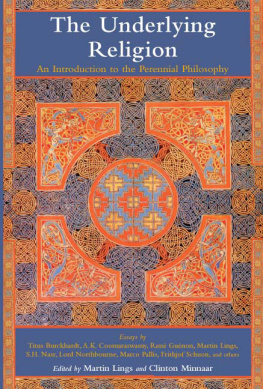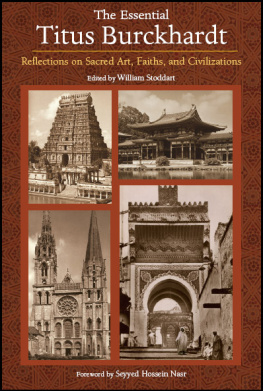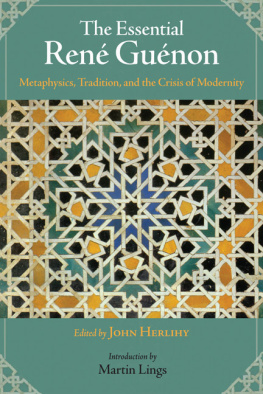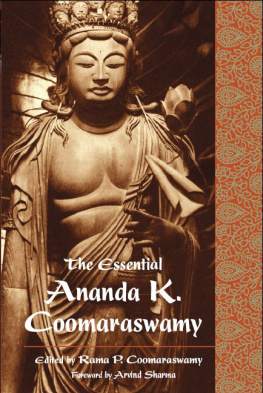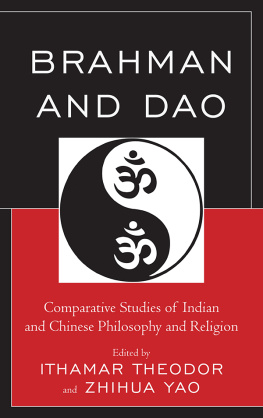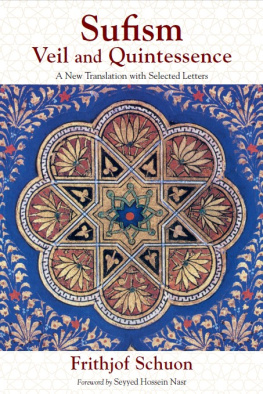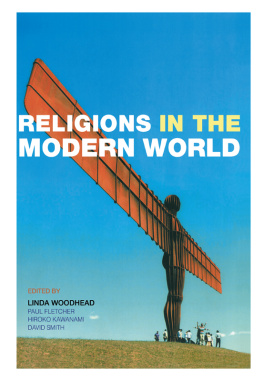ACKNOWLEDGMENTS
The editors wish to thank the following authors, editors, and publishers for their consent to publish the articles in this anthology.
- Religion and Tradition: Lord Northbourne, Religion in the ModernWorld, Ghent, NY: Sophia Perennis, 2001, pp. 3-11.
- Modernism: The Profane Point of View: Lord Northbourne, Reli-gion in the Modern World, Ghent, NY: Sophia Perennis, 2001, pp. 12-19.
- Looking Back on Progress: Lord Northbourne, Looking Back onProgress, Ghent, NY: Sophia Perennis, 1995, pp. 7-22.
- The Past in the Light of the Present & The Rhythms of Time: Martin Lings, Ancient Beliefs and Modern Superstitions, Cambridge, UK: Archetype, 2001, pp. 1-23.
- Evolutionism: Titus Burckhardt, Mirror of the Intellect, translated by William Stoddart, Cambridge, UK: Quinta Essentia, 1987, pp. 30-45.
- Modern Science and the Dehumanization of Man: Philip Sherrard, Studies in Comparative Religion 1976, 10 (2), pp. 74-93.
- Oriental Metaphysics: Ren Gunon, Tomorrow 1964, 12 (4), pp. 6-16, translated by J.C. Cooper.
- The Decisive Boundary: Martin Lings, Symbol & Archetype: AStudy of the Meaning of Existence, Cambridge, UK: Quinta Essentia, 1991, pp. 13-18.
- Scientia Sacra (abridged): Seyyed Hossein Nasr, Knowledge and theSacred, Edinburgh: Edinburgh University Press, 1981, pp. 130-159.
- Understanding and Believing: Frithjof Schuon, Logic and Transcen-dence, translated by Peter N. Townsend, London: Perennial Books, 1975, pp. 198-208; revised translation by Mark Perry and JeanPierre Lafouge.
- The Symbol: Martin Lings, The Book of Certainty: The Sufi Doc-trine of Faith, Vision, and Gnosis, Cambridge, UK: Islamic Texts Society, 1992, pp. 35-40.
- The Traditional Doctrine of Symbolism: Ghazi bin Muhammad, Sophia 2001, 7 (1), pp. 85-108.
- The Language of the Birds: Ren Gunon, Fundamental Symbols:The Universal Language of Sacred Science, compiled and edited by Michel Valsan, translated by Alvin Moore, Jr., revised and edited by Martin Lings, Cambridge, UK: Quinta Essentia, 1995, pp. 39-42.
- Symplegades (abridged): Ananda K. Coomaraswamy, Studies inComparative Religion 1973, 7 (1), pp. 35-5
- The Spirit of the Times: Martin Lings, The Eleventh Hour: TheSpiritual Crisis of the Modern World in the Light of Tradition andProphecy, Cambridge, UK: Archetype, 2002, pp. 53-69.
- Paths That Lead to the Same Summit: Ananda K. Coomaraswamy, The Bugbear of Literacy, Pates Manor, Bedfont: Perennial Books, 1979, pp. 50-67.
- Mysticism: William Stoddart, Sacred Web 1998, 2, pp. 65-77.
- The Perennial Philosophy: Frithjof Schuon, in The UnanimousTradition: Essays on the Essential Unity of All Religions, edited by Ranjit Fernando, translated by William Stoddart, Colombo: Sri Lanka Institute of Traditional Studies, 1991, pp. 21-24.
- Foundations of an Integral Aesthetics: Frithjof Schuon, Esoterismas Principle and as Way, translated by William Stoddart, Pates Manor, Bedfont: Perennial Books, 1981, pp. 177-182; revised translation by Mark Perry and Jean-Pierre Lafouge.
- An Introduction to Sacred Art: Titus Burckhardt, Sacred Art inEast and West: Its Principles and Methods, translated by Lord Northbourne, Louisville, Kentucky: Fons Vitae/Bloomington, IN: World Wisdom, 2001, pp. 11-20.
- Do Clothes Make the Man? The Significance of Human Attire: Marco Pallis, The Way and the Mountain, London: Peter Owen, 1991, pp. 141-159.
- Virtue and Morality: Tage Lindbom, Studies in Comparative Reli-gion 1975, 9 (4), pp. 227-235.
- Frithjof Schuon and Prayer: Reza Shah-Kazemi, Sophia 1998, 4(2), pp. 180-193.
- A Letter on Spiritual Method: Titus Burckhardt, Mirror of theIntellect, translated by William Stoddart, Cambridge, UK: Quinta Essentia, 1987, pp. 251-252.
Afterword: The Revival of Interest in Tradition: Whitall N. Perry, in The Unanimous Tradition: Essays on the Essential Unity of All Reli-gions, edited by Ranjit Fernando, Colombo: Sri Lanka Institute of Traditional Studies, 1991, pp. 3-16.
AFTERWORD: THE REVIVAL OF INTEREST IN TRADITION
Whitall N. Perry
Since the concept revival is contingent upon the notion of loss through one way or another of something antecedentin this case Traditionit is necessary if speaking about revival, first to understand in what, exactly, this loss consists.
Religion in the current usage of the term cannot be taken as the equivalent of Tradition, for the ritual practice of Religion is a specific act done in a specific place at a specific time to the exclusion of other acts, places, and times, whereas Tradition by protraction encompasses all acts and places and times, leaving nothing outside of itself; moreover, a great deal of what passes for Religion can still be found in the world, whilst Tradition in its integral and living sense hardly at all survives. Hence it may sound paradoxical to state, as we now do, that Tradition has its origin in Religion. Reduced to a formula: Religion is Revelation from God to man, with Tradition being its application and full extension in every domain.
All Revelation, furthermore, proclaims its authenticity or orthodoxy through participation in the ternary Unity-Infinity-Perfection, these being inseparable attributes of the Absolute. Unity, in that the unique message every great religion promulgates in common with every other is the Reality of God and the illusoriness of the world, with a Way by which man can leave the unreal for the Real. Infinity, in that a plenitude of originality characterizes each revelation to the exclusion of every other: a person in a Buddhist world, for example, could never mistake it for an Islamic one, and vice versa, whereas a heterodox religion betrays its nature through aping the original source or sources from which it has deviated; it has no fresh, spontaneous avataric perfume of its own. As for Perfection, each true religion manifests this through the supranatural beauty of its forms.
Earliest humanityin accordance with all scripture, and counter to what the evolutionists would have us believeparticipated unitively in a Primordial Religion, which was a transparent state of beatitude where human intellection spontaneously duplicated Divine Revelation, or in Biblical parlance, where man spoke with God.
As he lost his unific vision and our cycle of humanity accordingly unfolded, there came the racial divisions, with corresponding revelations adapted to needs of the different periods and sectors of mankind. Those known to us comprise notably Hyperborean shamanism with its Taoist, Bn, and Shinto branches; the shamanism of Siberia and the indigenous peoples of the Western Hemisphere; the animistic faiths of Africa and Southeastern Asia; the Indo-Iranian and Indo-European cultures manifesting chiefly in Hinduism, Buddhism, Zoroastrianism, Orphism, and the Celto-Germanic religionswith elements from other Near-Eastern groups, mainly Egyptian Hermeticism; and then the Semitic monotheisms or Abrahamic religions: Judaism, Christianity, and Islam.
It can happen that traditional forms remain, where their religious context has expired, and the opposite is equally true. Thus, for example, Orphic currents have come down through Pythagoreanism, Platonism, and Neoplatonism into the Christian and Arab spheres. Again, Germanic forms have left their traces in European ornamentation, mythologies, superstitionsfrom superstare, meaning something that stands over when the understanding of it has been lostand fairy tales.

